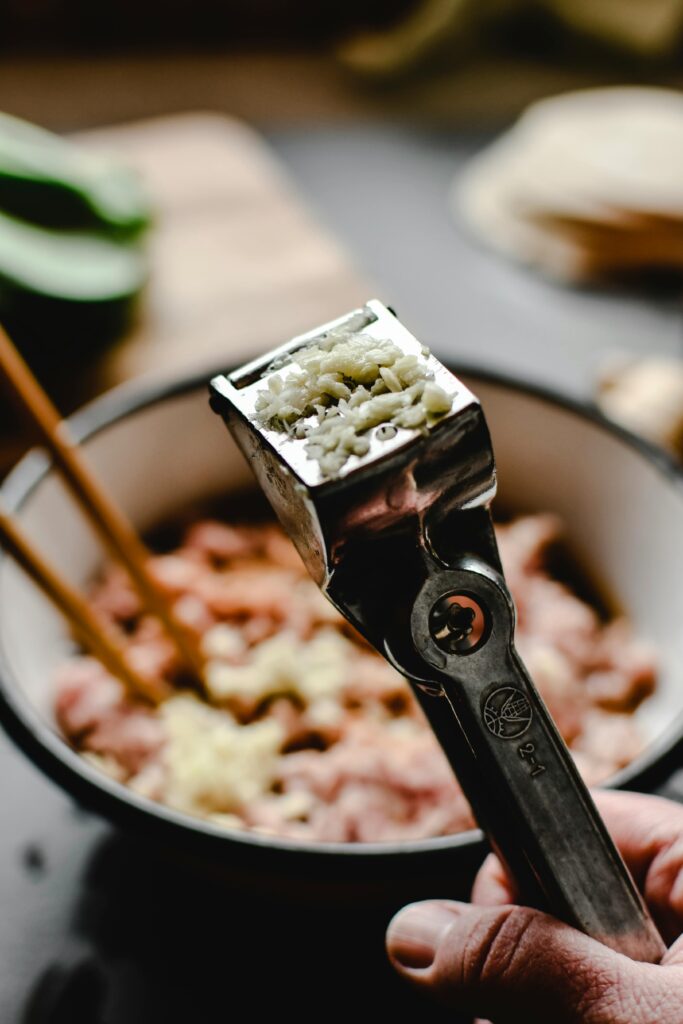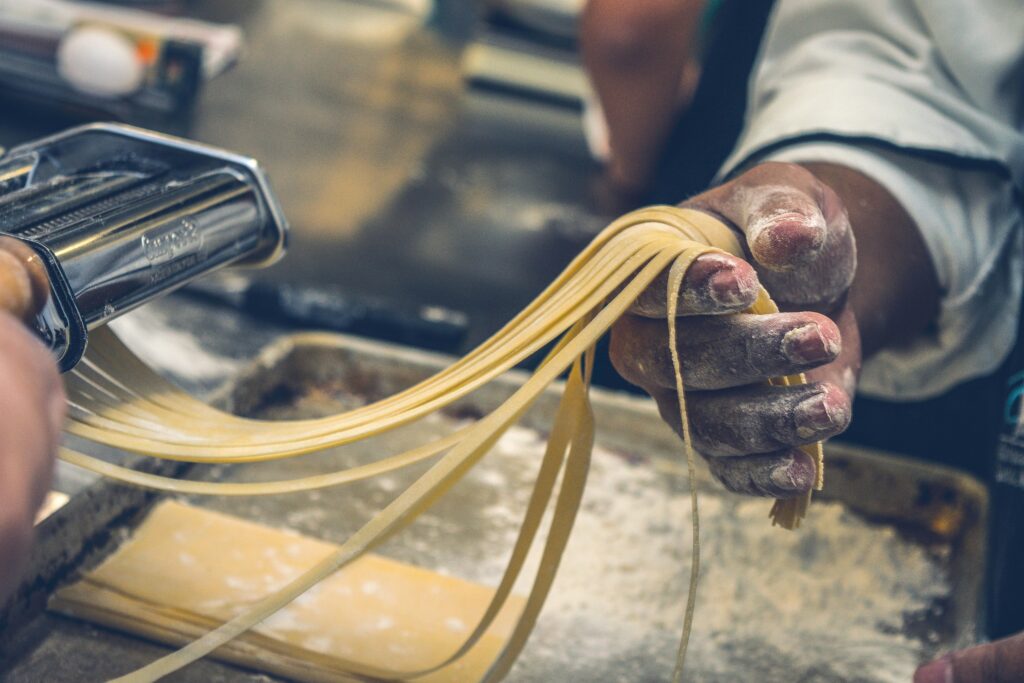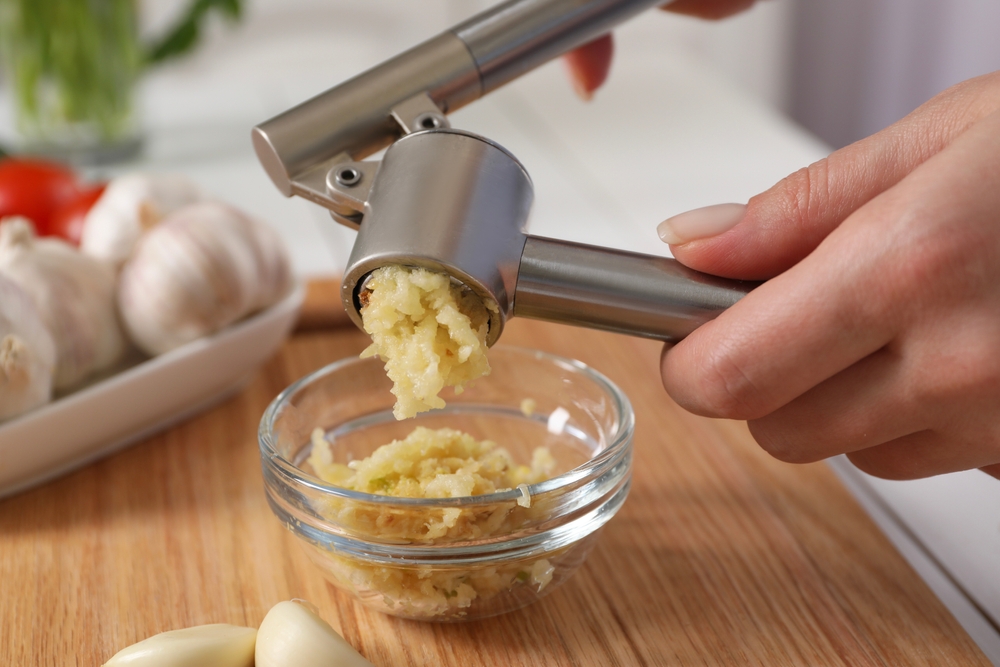Every year new kitchen tool appear on store shelves, each one marketed as the secret to faster, easier cooking. While some tools genuinely improve efficiency, many are single-use items that add clutter, break quickly, or simply duplicate what you can already achieve with basic equipment. A drawer full of gadgets may look impressive, but in practice, most cooks rely on a handful of reliable tools every day. Knowing which items to avoid not only saves you money, it also makes your kitchen more organized and functional. By focusing on versatile tools like knives, skillets, and colanders, you can prepare meals just as effectively without filling your cupboards with devices you rarely touch. This list highlights 12 common kitchen tools that are not worth buying and offers smarter alternatives you can use instead.
1. Garlic Press

A garlic press is often marketed as a tool that saves time, but it introduces more problems than it solves. The design forces cloves through small holes, which makes cleaning a struggle since garlic fibers and oils stick stubbornly inside. Even after washing, the smell can linger, especially with cheaper models made of low-quality materials. Presses also waste part of each clove, leaving behind pulp that could add flavor to your dish. On top of that, the texture of pressed garlic is less versatile because it comes out as a paste that oxidizes quickly, making the taste sharper or even slightly bitter. A chef’s knife, by contrast, can crush, mince, slice, or chop garlic with ease, giving you more control over flavor and texture. Since knives are already essential in cooking, using one for garlic eliminates the need for an extra tool and keeps your kitchen setup simpler.
Use instead: A sharp chef’s knife.
2. Avocado Slicer
An avocado slicer may look like a clever gadget, but it quickly proves unnecessary. These slicers are usually made of flimsy plastic or thin metal that struggles with firm avocados, and they do not adjust well to different sizes or ripeness levels. The pitting section, often a round blade or set of prongs, can be awkward and even unsafe compared to proper knife techniques. On top of that, slicers often leave avocado flesh behind, which leads to more waste. With a chef’s knife, you can cut through the skin, twist to remove the pit, and slice the flesh into neat pieces. A spoon then scoops the slices out cleanly, giving you the exact size and shape you want. This method works every time, requires no special gadget, and keeps your tools more versatile.
Use instead: A chef’s knife and a spoon.
3. Banana Slicer
A banana slicer is a curved piece of plastic that creates even slices, but its usefulness ends there. Bananas are one of the easiest fruits to cut, and a knife slices them in seconds with no effort. A slicer, on the other hand, requires cleaning, takes up storage space, and cannot be used for anything else. Many models only fit bananas of a certain size, which makes them even less practical. Using a knife is not only faster, it allows you to control the thickness of slices depending on whether you want small pieces for cereal, thicker slices for baking, or chunks for fruit salads. Since knives can also handle strawberries, kiwis, or apples, they add far more value compared to a single-use banana cutter.
Use instead: Any kitchen knife.
4. Electric Can Opener
Electric can openers take up space, require electricity, and are prone to breakdowns, making them less reliable than their manual counterparts. They often stop mid-cut when the motor fails or when the gears wear down, which leaves cans half-open and unsafe. For small kitchens, dedicating counter space to such a device does not make sense. Manual can openers are compact, inexpensive, and last for years without maintenance. They require minimal effort, work on cans of all sizes, and store easily in a drawer. Since they do not rely on power, they also come in handy during outages or when camping. Their durability and simplicity make them a better investment, especially for kitchens that value efficiency and space-saving.
Use instead: A manual can opener.
5. Egg Separator
Egg separators promise neat yolk and white separation, but they do not improve on the speed or ease of simply using the shell or your hands. Plastic versions break easily, while metal ones still require scrubbing after every use. Separating eggs by hand is not only faster but also more reliable, as you can feel the yolk and prevent it from breaking. Cracking the egg and passing the yolk between shell halves allows the white to fall naturally into a bowl. Alternatively, you can crack the egg into your hand, letting the white slip through your fingers while holding the yolk intact. Both techniques are easy to learn, require no extra equipment, and avoid adding clutter to your drawer.
Use instead: Your hands or the eggshell itself.
6. Single-Use Salad Spinner
Salad spinners are bulky devices that quickly dry greens, but they take up more storage space than they are worth in many kitchens. The spinning mechanism adds extra parts that can trap water and are inconvenient to clean. For people who only eat salads occasionally, the tool is unnecessary since a clean kitchen towel can dry greens just as well with a few pats. For those who make salads more often, combining a colander with a towel or paper towels is a simpler solution. This method drains water effectively while keeping your kitchen free of a single-use item that occupies half a shelf. Since colanders also work for pasta, beans, and rinsing vegetables, they add more versatility than a bulky spinner ever could.
Use instead: A colander and a clean kitchen towel.
7. Electric Wine Opener
Electric wine openers look modern and seem like they make opening bottles easier, but they are less practical than they appear. Many models are large, heavy, and require batteries or frequent recharging, which adds cost and inconvenience. They are also prone to breaking down, especially the gears inside that strip easily, leaving you stuck with a half-opened bottle. These devices can also struggle with older or synthetic corks, which makes them unreliable in real use. By contrast, a traditional corkscrew or waiter’s friend is compact, durable, and easy to operate once you learn the simple twisting and pulling motion. These manual openers last for years with almost no maintenance, work on all cork types, and can even fit neatly into a pocket or drawer. They save space, are affordable, and eliminate the risk of being left with a broken electric gadget during dinner.
Use instead: A corkscrew or waiter’s friend.
8. Panini Press
A panini press can make a good toasted sandwich, but the drawbacks usually outweigh the benefits. These machines are large and take up significant counter or cupboard space, and many are slow to heat up. Cleaning them can be frustrating, as grease and crumbs stick to the ridged plates that are not always removable. They are also limited to making pressed sandwiches, which means they rarely get used often enough to justify the space they take. The same results can be achieved using items you already have in your kitchen. A skillet or griddle pan, paired with a second heavy pan pressed on top, crisps bread and melts fillings just as effectively. Cast iron works especially well, as it distributes heat evenly and provides enough weight to press down sandwiches for the same café-style texture. This method saves space, avoids the hassle of cleaning a bulky appliance, and gives you flexibility for other stovetop cooking.
Use instead: Two skillets or a cast iron pan.
9. Specialty Apple Corer and Slicer
Apple corers and slicers are designed to cut apples into wedges quickly, but they rarely live up to their promise. The blades are often weak and can get stuck mid-cut, especially with firmer apples, making the process messy and frustrating. They also tend to cut unevenly, leaving you with pieces of varying thickness, and they do not always remove the entire core cleanly. On top of that, these tools take up drawer space and only work for apples or similarly sized fruits. A paring knife or chef’s knife, by comparison, is more reliable, gives you control over the size and shape of each slice, and works with a wider variety of produce. With a little practice, you can core an apple in seconds and slice it into wedges or thin slices for baking, salads, or snacking. A knife is versatile, compact, and far more effective than a single-use corer.
Use instead: A sharp paring knife or chef’s knife.
10. Pasta Maker Machine

A pasta maker machine may sound like an exciting investment, but it is rarely worth it for the average home cook. These machines are heavy, expensive, and require a lot of counter space to set up and use. They also demand extra cleaning, especially in the rollers and cutters where dough tends to stick and dry. Unless you plan to make pasta every week, they end up gathering dust. For occasional pasta-making, you can achieve great results with tools you already own. A rolling pin can flatten dough into sheets, and a sharp knife can cut noodles to any width you want. This process is slower than using a machine, but it saves storage space and avoids the expense. For most households, good-quality dried pasta from the store is consistent, affordable, and always available, making a machine unnecessary unless you are committed to making fresh pasta regularly.
Use instead: A rolling pin and knife.
11. Butter Cutter or Butter Dispenser
Butter cutters and dispensers are marketed as convenient, but they do not add real value to a kitchen. These gadgets are designed to slice pre-measured pats of butter or push out softened sticks, but they are prone to clogging, breaking, or jamming. They also add another item to clean, and they only work for butter, which limits their usefulness. A butter knife, by contrast, is versatile and simple. It can spread butter, cream cheese, peanut butter, or jam, and it works just as well for cutting butter into cubes for baking. A small kitchen knife also provides more control, letting you slice exactly the amount you need instead of relying on preset sizes. Since knives are already part of every kitchen, there is no need to add a specialized butter gadget that takes up space and performs no better than what you already own.
Use instead: A butter knife or small kitchen knife.
12. Yogurt Maker
Yogurt makers appeal to people who want to make their own dairy products, but they are usually more trouble than they are worth. They require storage space, specific containers, and still need you to heat and cool milk separately before using the machine. The process often produces inconsistent results unless you experiment with timing and temperature, which can be frustrating. A heavy pot and thermometer can do the same job without requiring another device, and with an oven light or insulated cooler, you can keep yogurt at the right temperature for incubation. This method is more flexible and does not tie you to a single gadget. For most people, however, high-quality yogurt from the store is affordable, widely available, and saves both time and effort. Unless you plan to make large batches frequently, a yogurt maker is not worth the cost or the storage space.
Use instead: A heavy pot and thermometer, or store-bought yogurt.
Read More: 12 Kitchen Knives Every Cook Must Know (and What They’re Really For)
Disclaimer: This article was created with AI assistance and edited by a human for accuracy and clarity.

